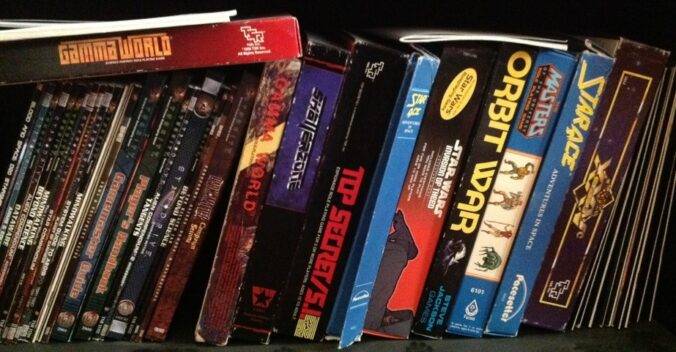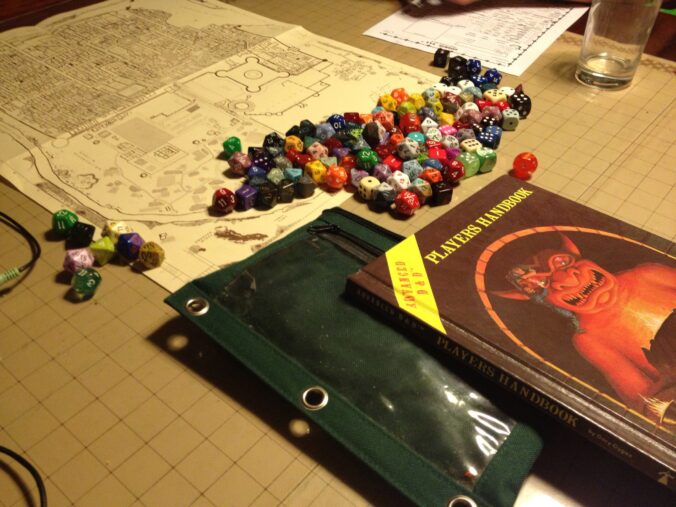This last Friday I had the joy to play in Theron Bretz’s Stormbringer RPG game which he ran at NTRPGCon this year. I’m doing a series of posts analyzing combat speed (what speeds or slows down combat in RPGs) and this was a great game to play in and analyze. Before I get into combat speed analysis (which I’ll tackle in my next post), let’s take a look at a couple of incarnations of the Basic Role-Playing game system.
Basic Role-Playing (and it’s ancestor, Runequest)

Basic Roleplaying
The Basic Role-Playing game (BRP) system is a percentile-dice-based system used in many role-playing games designed by Chaosium (most notably, Call of Cthulhu). It’s ancestor was the 1978 game Runequest. In Britain in the 1980s, RuneQuest was recognized by the gaming world as one of the ‘Big Three’ games with the largest market share (the others being Dungeons & Dragons and Traveller).
At its core, it has a lot of D&D-style mechanics (abilities, damage, hit points, etc.), but with a percentile based skill system and some other elements layered in. The BRP Character Sheet from Chaosium gives you a quick feel for the stats at work in the system.
Basic Role-Playing eventually became the GURPs / Savage Worlds-style generic system based on Runequest, with Runequest (now in it’s 6th Edition) remaining the leading Fantasy incarnation of the venerable rules.
Other variants such as Chaosium’s Magic World allow you to incorporate interesting magic system to emulate Stormbringer’s setting (even though Chaosium has long lost the license from Moorcock).
If you’re looking for interesting or novel magic systems, the BRP family of products has many options, and is modularized to allow you to toggle on or off whatever magic subsystems you want for your setting.
Call of Cthulhu
I have looked over the Basic Role-Playing game system and its variants (Call of Cthulhu, Ringworld, Elfquest, etc.) over the years, but last month (when I played in a Cthulhu game) was the first time I’d ever played in one of these percentile-dice-based systems. It always struck me as overly crunchy (due to long skill lists and percentile notes all over the place). However, the Cthulhu game ran amazingly fast and I was very surprised at how enjoyable the system was to play!

Brandon Peterson’s Cthulhu game — we filled in the stats as we tried to do things (our characters had amnesia!)
Stormbringer RPG
My experience a few weeks later in Theron’s Stormbringer game was much the same as in Call of Cthulhu: combat which was immersive, cinematic, and fast-moving.
The Stormbringer RPG game which Theron ran used the 1st edition rules first published by Chaosium back in 1981. The setting is based on the Elric of Melniboné books by Michael Moorcock. The game takes its name from Elric’s sword, Stormbringer.

Stormbringer Character Sheet using percentile-dice based skills
This game was unbelievably fun. Part of it was that Theron was such a great GM. Part of it was the theater-of-the-mind style which Theron used: I always find theater-of-the-mind to be some much more immersive, especially with Fantasy games (sneaking past a 200-yard long sleeping dragon just can’t be replicated with minis!). Part of it was the evocative Melniboné setting which Theron described so well.
Some of it was the system itself.

Cover art really brought out the Moorcock vibe!
The game is not particularly balanced (like the source material, our Melnibonéan sorcerer clearly out-powered a mundane rogue character I was playing). For a con game, I don’t mind being unbalanced (though I might care more in a longer term campaign). But what stood out was how fast-paced the game was, while still being evocative and cinematic.

Stormbringer 1st Edition Box Set really had the old-school feel
Characters, even though they had a lot of experience (maybe equating to Level 7 in D&D, though BRPG doesn’t have levels per se), still only had 10 to maybe 13 hit points. Combat was gritty and death seemed never more than a couple of bad dice rolls away.

Old-school dungeon crawl but with the distinct feel of Melniboné
In some ways it was more satisfying that AD&D combat. Characters had a chance to roll in attempt to parry a blow If you scored a particularly good hit, you could take (or inflict) a ‘major wound’ which the GM would look up on a table. Between major wounds descriptions from tables, and Theron’s own flavorful descriptions of combat, the battles hit the zen-like sweet-spot of being both super-fast and super-descriptive.
All-in-all, this was one amazing game. Great players, great GM, and a system that flowed fast and really made you feel like you were in Melniboné!
Getting Into BRP
I really loved the Stormbringer and Cthulhu games and the simple-but-flavorful BRP system. I did a bit of research and found that BRP could be a nice potential fit for games that need a particularly exotic magic system to emulate non-Tolkien style Fantasy games. BRP Fantasy systems come in many flavors. Here are a few top choices and some notes I made based on reviews.
- Runequest (6th Ed.) — Chaosium’s long-lived product with five modular magic systems to choose from (including a Rune magic system). Based on some reviews, I might find this incarnation a bit too crunchy for my tastes.
- MagicWorld — Another Chaosium version that incorporates many Stormbringer setting rules, but with the Moorcock IP stripped out.
- OpenQuest — There is a Runequest SRD, and OpenQuest takes the SRD bits, streamlines it, and represents it in simpler form. Fewer skills for example. This would probably be my favorite one to start with. It is reviewed here. And as an even simpler first step, the free and small OpenQuest Basic might be just the place to start.
While I’d likely look elsewhere for generic, supers, or Sci Fi rpg systems, the magic flavors in the BRP products have enough appeal to warrant consideration if you’re looking at a non-traditional Fantasy campaign. In any case, I loved all my BRP experiences and I am gladly adding this system to my short-list of game systems to consider for GMing or playing at cons or in home games!
Combat Metrics
Aside from being cool systems to play, in my next article I’ll talk about how BRP systems play out with regard to combat speed.













Recent Comments